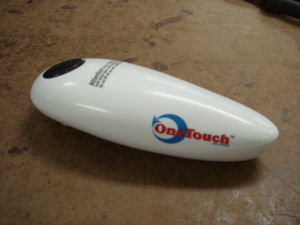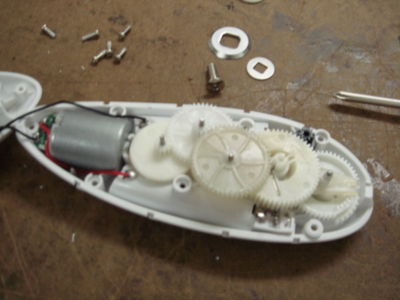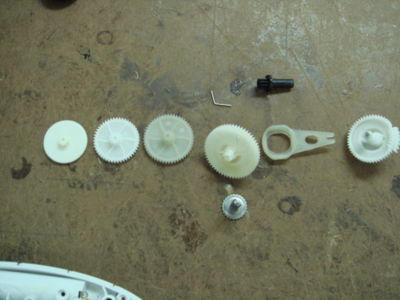Automatic can opener
From DDL Wiki
Contents |
Product Dissection
The following notes were taken prior to and during product dissection.
Function/Purpose:
This can opener provides a low effort method to opening any size can.
Inputs/Outputs:
- INPUTS: Battery Power
- INPUTS: Positioning of opener
- INPUTS: Press button until unit begins to move
- OUTPUTS: Cut through can to open
- OUTPUTS: Rotates around can
Use:
The automatic can opener must first be put into the right position for it to complete its task properly. This correct position is on top of the can. Once it is in the right position the user just has to hold down the button until the opener turns on. Once it is on the user can just sit back and observe. The can opener will eventually make its way all the way around the can, unless the can is larger than standard tin cans. If this is the case, the can opener simply has to be run multiple times until the top is completely cut. Once the can opener has completed its job, the user can simply pick up the can opener. Since there is a magnet on the can opener the lid is attached and can be easily discarded.
Functional Operation:
1. Opener is positioned on can, which presses a safety switch.
2. Button on top is pressed to close main circuit using manual switch.
3. Motor engages and turns several gears to drive movement wheel and move the cutting wheel into position.
- There are four gears used to gear down the movement wheel, with a fifth gear to further slow the cutting wheel.
4. As cutting wheel gets into position, the main circuit is closed using an automatic switch that is pressed by the top of the cutting wheel shaft.
5. The cutting wheel is even further geared down using a secondary portion to its gear. This allows it to rotate roughly ten degrees about six times through the cutting process.
6. When the cycle is nearly completed the cutting wheel is retracted again and the automatic switch is released, stopping the opener.
7. A magnet on the underside of the opener lifts the top of the can with it when the opener is lifted off.
Components
The can opener has several components and electrical assemblies. It appears that most are purchased from suppliers while casings are injection molded in house. Some components seem like they could be removed to allow for a faster and easier assembly. Also, with a large enough scale of production, it may be beneficial to begin making some of the injection molded gears in house as well. Much more detail as to what individual components are used, what their purpose is, and their likely manufacturing processes.
The geartrain is very compact although it does allow for a large conversion from motor speed to torque allowing for an easily made cut.
DFMA, FMEA, DFE Analysis
Design for Manufacturing:
- The upper and lower casing are both made in house by using the method of injection molding.
- Most of the other parts like the screws, pressure switch and the motor are bought by suppliers, so it won’t be hard to buy.
- The Gear components in the gear train in this product should be currently bought from other suppliers as well and could be made in house using the process of injection mold plastics, so it shouldn't be hard to produce.
- Movement wheel and the washers are both stamped
- The Cap screw and the magnet are both produced by cast
- Overall, the whole manufacturing process is very cost effective and most of them are produced by molding and stamping.
Design for Assembly:
- The casings are securely attached by screws. It is very easy, simple and straight forward.
- The internal wiring has obvious tracks to help guide wires so it will be aligned.
- The Circuit board and the capacitors are soldered in so it will be secured and hard to disassembly.
- Gear Trains and the movement gear are all secured by shafts
- The Bent Pin is used to attach the movement gear to the movement wheel
Design for Disassembly:
- Easy dissemble for most parts as most of them are attached by shafts and screws
- The more difficult areas would be the motor itself and the circuit board (soldered in)
Failure Modes and Effective Analysis
Design for Environment
- This product of the automatic can opener is can definitely be more environmentally friendly by using better materials of components (gears).
- Use better manufacturing processes and better handling of the waste of harmful materials.
- The design itself can be more optimal, so it wouldn’t require more than required of these harmful materials.










